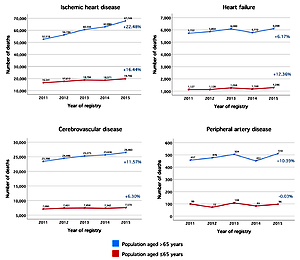Current issue
Archive
Manuscripts accepted
About the Journal
Editorial office
Editorial board
Abstracting and indexing
Subscription
Contact
Ethical standards and procedures
Most read articles
Instructions for authors
Article Processing Charge (APC)
Regulations of paying article processing charge (APC)
RESEARCH PAPER
Analysis on Cause-Specific Atherothrombotic Cardiovascular Disease Mortality in Mexico: 2011-2015
1
Instituto Nacional de Ciencias Médicas y de la Nutrición “Salvador Zubirán”, Mexico
2
Internal Medicine and Clinical Research. Paracelsus S.A. de C.V. Mexico City; Mexico., Mexico
3
Centro Médico ABC. Mexico City, Mexico., Mexico
4
Clinical Research and Biostatistics. Grupo ANLTYK. Mexico City; Mexico., Mexico
Submission date: 2020-12-26
Final revision date: 2022-05-24
Acceptance date: 2022-05-26
Online publication date: 2022-05-29
Corresponding author
Erwin Chiquete
Instituto Nacional de Ciencias Médicas y de la Nutrición “Salvador Zubirán”, Vasco de Quiroga #15, 14000, Mexico City, Mexico
Instituto Nacional de Ciencias Médicas y de la Nutrición “Salvador Zubirán”, Vasco de Quiroga #15, 14000, Mexico City, Mexico
KEYWORDS
TOPICS
ABSTRACT
Introduction:
In Mexico, cardiovascular disease (CVD) represents the most important cause of mortality and disability. We aimed to analyze the mortality rate due to specific causes of atherothrombotic CVD from 2011 to 2015.
Material and methods:
We analyzed 3,105,975 death certificates issued from January 2011 through December 2015. The 10th version of the International Classification of Diseases (ICD) codes was used to select CVD death records for ischemic heart disease, heart failure, cerebrovascular disease, and peripheral artery disease. Regional analyses from the different federal states were also performed.
Results:
We analyzed 594,370 (19.1%) death certificates. Age-standardized CVD mortality showed a more stable pattern, from 96.7 per 100,000 people in 2011, to 111.7 per 100,000 in 2015. Cause-specific mortality rates increased more during the period for ischemic heart disease (63.8 vs. 74.8 per 100,000 people, in 2011 vs. 2015, respectively), as compared to heart failure (6.9 vs. 8.1 per 100,000 people), cerebrovascular disease (28.4 vs. 30.2 per 100,000 people), or peripheral artery disease (0.52 vs. 0.55 per 100,000 people). Overall, the survival age was significantly shorter in men (mean age at death 72.04±16.23 years) than in women (77.73±14.77). Ischemic heart disease and cerebrovascular disease showed the shortest survivals. The number of deaths increased steadily among the older population, with the steepest increase for overall ischemic heart disease over time.
Conclusions:
Atherothrombotic CVD mortality in Mexico increased during the study period due to ischemic heart disease. Compared to their counterparts, survival age was shorter in men and in patients with ischemic heart disease and stroke.
In Mexico, cardiovascular disease (CVD) represents the most important cause of mortality and disability. We aimed to analyze the mortality rate due to specific causes of atherothrombotic CVD from 2011 to 2015.
Material and methods:
We analyzed 3,105,975 death certificates issued from January 2011 through December 2015. The 10th version of the International Classification of Diseases (ICD) codes was used to select CVD death records for ischemic heart disease, heart failure, cerebrovascular disease, and peripheral artery disease. Regional analyses from the different federal states were also performed.
Results:
We analyzed 594,370 (19.1%) death certificates. Age-standardized CVD mortality showed a more stable pattern, from 96.7 per 100,000 people in 2011, to 111.7 per 100,000 in 2015. Cause-specific mortality rates increased more during the period for ischemic heart disease (63.8 vs. 74.8 per 100,000 people, in 2011 vs. 2015, respectively), as compared to heart failure (6.9 vs. 8.1 per 100,000 people), cerebrovascular disease (28.4 vs. 30.2 per 100,000 people), or peripheral artery disease (0.52 vs. 0.55 per 100,000 people). Overall, the survival age was significantly shorter in men (mean age at death 72.04±16.23 years) than in women (77.73±14.77). Ischemic heart disease and cerebrovascular disease showed the shortest survivals. The number of deaths increased steadily among the older population, with the steepest increase for overall ischemic heart disease over time.
Conclusions:
Atherothrombotic CVD mortality in Mexico increased during the study period due to ischemic heart disease. Compared to their counterparts, survival age was shorter in men and in patients with ischemic heart disease and stroke.
Share
RELATED ARTICLE
We process personal data collected when visiting the website. The function of obtaining information about users and their behavior is carried out by voluntarily entered information in forms and saving cookies in end devices. Data, including cookies, are used to provide services, improve the user experience and to analyze the traffic in accordance with the Privacy policy. Data are also collected and processed by Google Analytics tool (more).
You can change cookies settings in your browser. Restricted use of cookies in the browser configuration may affect some functionalities of the website.
You can change cookies settings in your browser. Restricted use of cookies in the browser configuration may affect some functionalities of the website.



